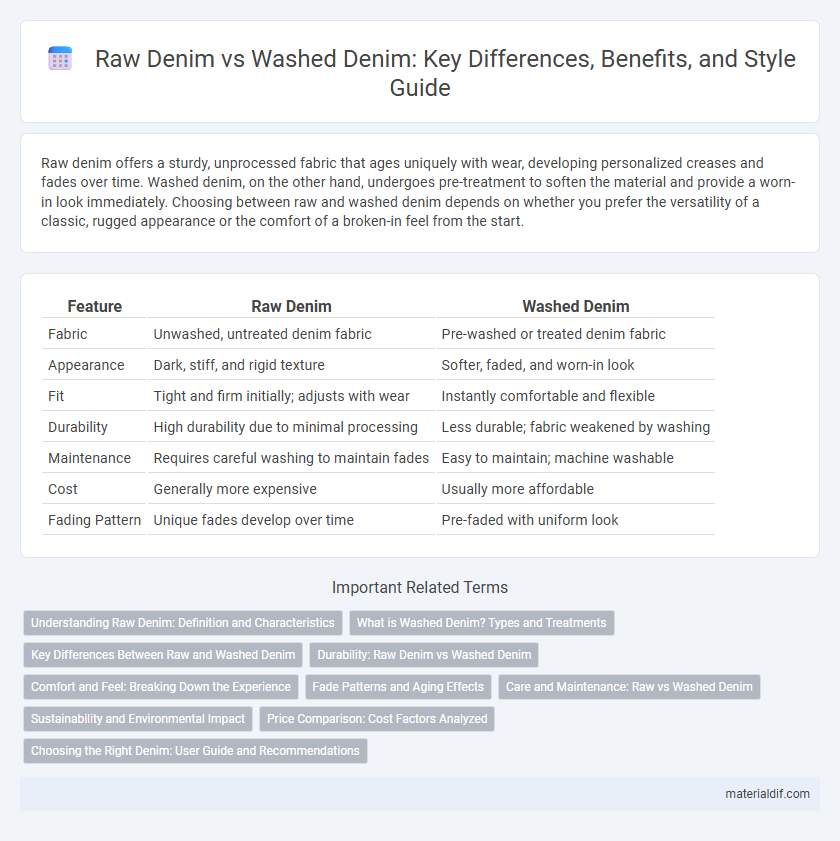Raw denim offers a sturdy, unprocessed fabric that ages uniquely with wear, developing personalized creases and fades over time. Washed denim, on the other hand, undergoes pre-treatment to soften the material and provide a worn-in look immediately. Choosing between raw and washed denim depends on whether you prefer the versatility of a classic, rugged appearance or the comfort of a broken-in feel from the start.
Table of Comparison
| Feature | Raw Denim | Washed Denim |
|---|---|---|
| Fabric | Unwashed, untreated denim fabric | Pre-washed or treated denim fabric |
| Appearance | Dark, stiff, and rigid texture | Softer, faded, and worn-in look |
| Fit | Tight and firm initially; adjusts with wear | Instantly comfortable and flexible |
| Durability | High durability due to minimal processing | Less durable; fabric weakened by washing |
| Maintenance | Requires careful washing to maintain fades | Easy to maintain; machine washable |
| Cost | Generally more expensive | Usually more affordable |
| Fading Pattern | Unique fades develop over time | Pre-faded with uniform look |
Understanding Raw Denim: Definition and Characteristics
Raw denim refers to denim fabric that has not undergone any washing or distressing processes after being dyed, preserving its stiff texture and deep indigo color. This untreated state allows raw denim to develop unique fades and creases over time based on the wearer's movements, enhancing the garment's individuality. High-quality raw denim typically features selvedge edges, dense cotton fiber weaving, and minimal chemical treatment, contributing to its durability and authentic aging process.
What is Washed Denim? Types and Treatments
Washed denim refers to denim fabric that has undergone various finishing processes to soften the material, enhance comfort, and create distinctive aesthetic effects. Common types of washed denim include stone-washed, acid-washed, and enzyme-washed, each involving unique treatments such as pumice stones, chemical bleaches, or cellulase enzymes to fade colors and produce texture variations. These treatments not only reduce stiffness and shrinkage but also provide a worn-in appearance and increase fabric breathability for everyday wear.
Key Differences Between Raw and Washed Denim
Raw denim is untreated and unwashed, maintaining its stiff texture and deep indigo color, which allows it to develop unique fades and creases over time based on individual wear patterns. Washed denim undergoes processes such as stone washing, enzyme washing, or chemical treatments, resulting in a softer feel, pre-faded appearance, and reduced shrinkage. Key differences include raw denim's durability and potential for custom aging compared to washed denim's immediate comfort and varied color options.
Durability: Raw Denim vs Washed Denim
Raw denim is known for superior durability as it undergoes minimal processing, retaining the fabric's original strength and resistance to wear. Washed denim, subjected to repeated washing and chemical treatments, typically shows faster signs of fading, thinning, and fabric weakening. The longevity of raw denim makes it preferable for those seeking long-lasting jeans that develop unique wear patterns over time.
Comfort and Feel: Breaking Down the Experience
Raw denim offers a stiff, rigid texture that molds uniquely to the wearer's body over time, delivering a personalized fit and distinctive fading patterns. Washed denim provides immediate softness and flexibility, prioritizing comfort right from the first wear through pre-washing treatments that reduce stiffness. The choice between raw and washed denim fundamentally impacts the tactile experience, with raw denim requiring a break-in period to achieve comfort while washed denim caters to those seeking instant wearability.
Fade Patterns and Aging Effects
Raw denim develops unique fade patterns through natural wear, showcasing personalized creases, whiskers, and honeycombs that highlight the wearer's lifestyle over time. Washed denim undergoes pre-treatment processes that soften the fabric and create a uniform color, reducing pronounced fade contrasts and resulting in a more consistent, vintage look. The aging effects on raw denim are more dynamic and unpredictable, while washed denim offers a stabilized, worn-in appearance from the outset.
Care and Maintenance: Raw vs Washed Denim
Raw denim requires minimal washing to preserve its natural indigo dye and develop unique fading patterns, so spot cleaning and air drying are recommended to maintain fabric integrity. Washed denim, treated with various washing processes, demands more frequent laundering and often benefits from gentle cycles to prevent color fading and fabric wear. Proper care for raw denim extends garment lifespan and enhances personalized wear characteristics, whereas washed denim offers immediate softness but may lose durability faster with repeated washes.
Sustainability and Environmental Impact
Raw denim offers a more sustainable option due to its minimal processing, reducing water usage and chemical treatments compared to washed denim. Washed denim typically requires significant water, energy, and chemical inputs, contributing to higher environmental pollution. Choosing raw denim supports eco-friendly practices by lowering carbon footprints and promoting longer garment lifespans through natural aging processes.
Price Comparison: Cost Factors Analyzed
Raw denim typically commands a higher price due to its unprocessed nature, premium cotton, and longer production time, whereas washed denim involves additional manufacturing steps like washing, distressing, and softening that increase labor and utility expenses. The cost factors influencing raw denim prices include the quality of selvage edges, dye concentration, and limited supply chains, while washed denim pricing reflects variability in wash techniques, chemical treatments, and fashion trends. Consumers often pay a premium for raw denim's durability and aging potential despite the initial unwashed stiffness, compared to washed denim's comfort and style variety derived from post-production modifications.
Choosing the Right Denim: User Guide and Recommendations
Raw denim offers a stiff, unwashed fabric that ages uniquely with wear, making it ideal for enthusiasts who prefer personalized fading and a durable, hard-wearing garment. Washed denim provides immediate comfort with a softened texture and pre-distressed appearance, suitable for casual wearers seeking low maintenance and style versatility. Choosing between raw and washed denim depends on the desired break-in experience, maintenance commitment, and preference for authentic aging versus ready-made softness.
Raw denim vs Washed denim Infographic

 materialdif.com
materialdif.com